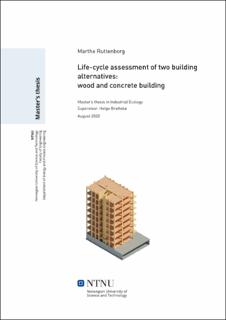| dc.contributor.advisor | Brattebø, Helge | |
| dc.contributor.author | Ruttenborg, Marthe | |
| dc.date.accessioned | 2021-09-20T16:54:56Z | |
| dc.date.available | 2021-09-20T16:54:56Z | |
| dc.date.issued | 2020 | |
| dc.identifier | no.ntnu:inspera:57317890:26326620 | |
| dc.identifier.uri | https://hdl.handle.net/11250/2779673 | |
| dc.description.abstract | Byggesektoren er en betydelig bidragsyter til klimaforandringer ved at de er ansvarlige
for 39 % av energirelaterte CO2 utslippene og 36 % av det globale energiforbruket
i 2018(Global Alliance for Buildings and Construction, International Energy Agency
and the United Nations Environment Programme, 2019). En reduksjon i bygningers
miljøp° avirkning gjennom livsløpet vil ha en langsiktig effekt p°a grunn av den lange
levetiden til bygninger (Sandberg et al., 2017).
Livsløpsvurdering (LCA) har blitt et veletablert verktøy for °a beregne utslippene over
levetiden til et produkt eller en prosess, og har vært et viktig verktøy for °a evaluere
miljøavtrykket til bygninger. Den totale virkningen beregnes basert p°a alle livssyklusstadier,
med tanke p°a alle utslipp i alle stadier.
Form° alet med denne studien er °a vurdere og evaluere miljøbelastningen av tre og betong
n° ar de brukes som byggematerialer i to leilighetsbygg, hvilke bygningselementer
som har størst bidrag til klimaendringer og p° avirkning av materialvalg i slike bygninger.
To forskjellige beregningsmetoder er brukt for °a undersøke miljøp° avirkningen av de to
bygningene; a) LCA-beregning ved bruk av Arda og generiske data fra Ecoinvent v3.2
og b) konsekvensberegning basert p°a produkt- og materialspesifikke miljødeklarasjoner
(EPD).
For trebygningen var de totale utslippene beregnet ved °a bruke generiske data 48
% høyere enn beregningen ved bruk av produkt spesifikke EPD-er, selv om utslippsfordelingen
mellom materialene i bygningen var lik for de to metodene. EPD-metoden
resulterte ogs°a i det laveste utslippsresultat for betongbygningen, men forskjellen mellom
metodene er betydelig redusert til 14 %. I likhet med trebygningen, var utslippsfordelingen
mellom materialene tilsvarende for begge metodene.
Utslippsfordelingen mellom bygningsdelene er ogs°a lik for de to bygningene. Gulv,
innvendige vegger og trapper og balkonger er de største bidragsyterne i begge bygningene
med begge metodene.
Det er flere usikkerheter knyttet til modellen som ble brukt i denne studien. Parametere
som antas °a ha høye usikkerheter eller som er store bidragsytere til miljøp° avirkningen,
er inkludert i en sensitivitetsanalyse. De beregnede resultatene fra denne analysen
har blitt diskutert og videre arbeid innen LCA-felt med bygninger og byggematerialer er
foresl ° att. | |
| dc.description.abstract | The building sector is a considerable contributor to climate change being responsible
for 39% of energy related CO2 emissions and 36% of global final energy use in 2018
(Global Alliance for Buildings and Construction, International Energy Agency and the
United Nations Environment Programme, 2019). Reducing the life cycle environmental
impact of buildings today will have a long term effect because of the long lifetime of
buildings (Sandberg et al., 2017).
Life cycle assessment (LCA) has become a well-established tool for calculating the
emissions over the life time of a product or process, and have been an important tool
for assessing the environmental footprint of buildings. The total impact is calculated
based on all the life cycle stages, considering all emissions in all stages.
This work’s objective is to assess and evaluate the environmental impact of wood and
concrete when used as construction materials in two apartment buildings, which building
elements have the largest contribution to climate change and the influence of material
choice in such buildings.
Two different calculation methods have been used to investigate the environmental impact
of the two buildings; a) LCA calculation using Arda and generic data from Ecoinvent
v3.2 and b) impact calculation based on product and material specific environmental
product declarations (EPDs).
For the wood building the total emissions calculated using the generic data was 48
% higher then the calculation using specific product EPDs even though the emission
distribution between the materials in the building was similar for the two methods.The
EPD method also resulted in the lowest emission result for the concrete building, but
the difference between the methods is significantly reduced to 14 %. As for the wood
building the emission distribution between the materials was similar both methods.
The emission distribution between the building parts is also similar for the two buildings.
Slabs, internal walls, and stairs and balconies are the largest contributors in both
buildings with both methods.
There are several uncertainties associated with the model used in this study. Parameters
which have been assumed to have high uncertainties or are large contributors to
the environmental impact have been included in a sensitivity analysis. The calculated
results from this analysis have been discussed and further work within the field of LCAs
on buildings and construction materials have been suggested. | |
| dc.language | | |
| dc.publisher | NTNU | |
| dc.title | Life cycle assessment of two building alternatives: wood and concrete | |
| dc.type | Master thesis | |
